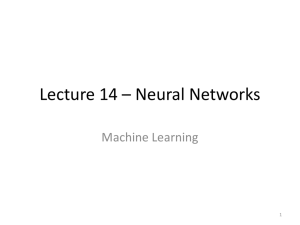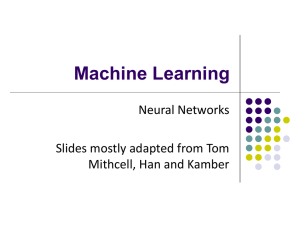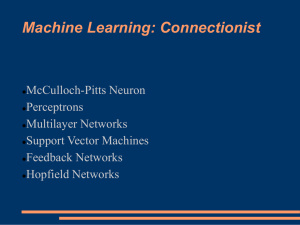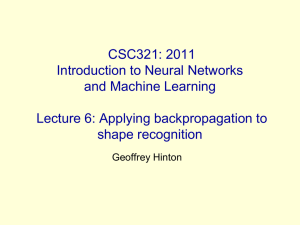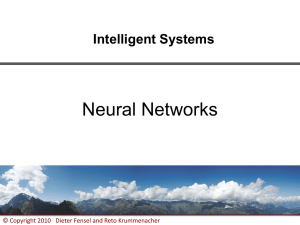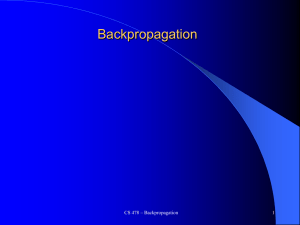pptx - CUNY
advertisement
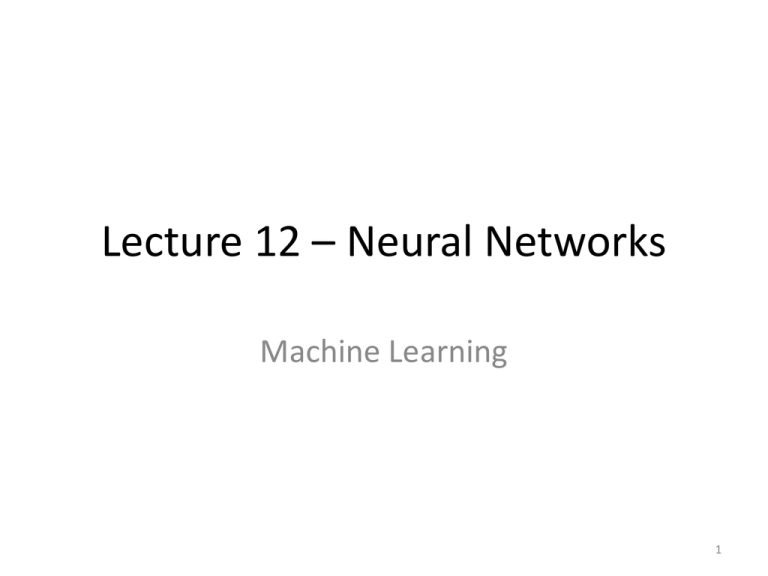
Lecture 12 – Neural Networks Machine Learning 1 Last Time • Perceptrons – Perceptron Loss – Training Perceptrons using Gradient Descent 2 Today • Multilayer Neural Networks – Feed Forward – Error Back-Propagation 3 Recall: The Neuron Metaphor • Neurons – accept information from multiple inputs, – transmit information to other neurons. • Multiply inputs by weights along edges • Apply some function to the set of inputs at each node 4 Types of Neurons Linear Neuron Logistic Neuron Perceptron Potentially more. Require a convex loss function for gradient descent training. 5 Multilayer Networks • Cascade Neurons together • The output from one layer is the input to the next • Each Layer has its own sets of weights 6 Linear Regression Neural Networks • What happens when we arrange linear neurons in a multilayer network? 7 Linear Regression Neural Networks • Nothing special happens. – The product of two linear transformations is itself a linear transformation. 8 Neural Networks • We want to introduce non-linearities to the network. – Non-linearities allow a network to identify complex regions in space 9 Linear Separability • 1-layer cannot handle XOR • More layers can handle more complicated spaces – but require more parameters • Each node splits the feature space with a hyperplane • If the second layer is AND a 2-layer network can represent any convex hull. 10 Feed-Forward Networks • Predictions are fed forward through the network to classify 11 Feed-Forward Networks • Predictions are fed forward through the network to classify 12 Feed-Forward Networks • Predictions are fed forward through the network to classify 13 Feed-Forward Networks • Predictions are fed forward through the network to classify 14 Feed-Forward Networks • Predictions are fed forward through the network to classify 15 Feed-Forward Networks • Predictions are fed forward through the network to classify 16 Error Backpropagation • We will do gradient descent on the whole network. • Training will proceed from the last layer to the first. 17 Error Backpropagation • Introduce variables over the neural network 18 Error Backpropagation • Introduce variables over the neural network – Distinguish the input and output of each node 19 Error Backpropagation 20 Error Backpropagation Training: Take the gradient of the last component and iterate backwards 21 Error Backpropagation Empirical Risk Function 22 Error Backpropagation Optimize last layer weights wkl Calculus chain rule 23 Error Backpropagation Optimize last layer weights wkl Calculus chain rule 24 Error Backpropagation Optimize last layer weights wkl Calculus chain rule 25 Error Backpropagation Optimize last layer weights wkl Calculus chain rule 26 Error Backpropagation Optimize last layer weights wkl Calculus chain rule 27 Error Backpropagation Optimize last hidden weights wjk 28 Error Backpropagation Optimize last hidden weights wjk Multivariate chain rule 29 Error Backpropagation Optimize last hidden weights wjk Multivariate chain rule 30 Error Backpropagation Optimize last hidden weights wjk Multivariate chain rule 31 Error Backpropagation Optimize last hidden weights wjk Multivariate chain rule 32 Error Backpropagation Repeat for all previous layers 33 Error Backpropagation Now that we have well defined gradients for each parameter, update using Gradient Descent 34 Error Back-propagation • Error backprop unravels the multivariate chain rule and solves the gradient for each partial component separately. • The target values for each layer come from the next layer. • This feeds the errors back along the network. 35 Problems with Neural Networks • Interpretation of Hidden Layers • Overfitting 36 Interpretation of Hidden Layers • What are the hidden layers doing?! • Feature Extraction • The non-linearities in the feature extraction can make interpretation of the hidden layers very difficult. • This leads to Neural Networks being treated as black boxes. 37 Overfitting in Neural Networks • Neural Networks are especially prone to overfitting. Logistic Regression • Recall Perceptron Error – Zero error is possible, but so is more extreme overfitting Perceptron 38 Bayesian Neural Networks • Inserting a prior on the weights – Similar to L2 Regularization • Error Backprop then becomes Maximum A Posteriori (MAP) rather than Maximum Likelihood (ML) training 39 Handwriting Recognition • Demo: http://yann.lecun.com/exdb/lenet/index.html 40 Convolutional Network • The network is not fully connected. • Different nodes are responsible for different regions of the image. • This allows for robustness to transformations. 41 Other Neural Networks • Multiple Outputs • Skip Layer Network • Recurrent Neural Networks 42 Multiple Outputs •Used for N-way classification. •Each Node in the output layer corresponds to a different class. •No guarantee that the sum of the output vector will equal 1. 43 Skip Layer Network • Input nodes are also sent directly to the output layer. 44 Recurrent Neural Networks • Output or hidden layer information is stored in a context or memory layer. Output Layer Hidden Layer Context Layer Input Layer 45 Recurrent Neural Networks • Output or hidden layer information is stored in a context or memory layer. Output Layer Hidden Layer Context Layer Input Layer 46 Time Delayed Recurrent Neural Networks (TDRNN) • Output layer from time t are used as inputs to the hidden layer at time t+1. Output Layer With an optional decay Hidden Layer Input Layer 47 Relationship to Maximum Margin Criteria • Perceptron can lead to many equally valid choices for the decision boundary • No guarantee of finding a global minimum 48 Next • Back to Maximum Margin Classifiers – Support Vector Machines – Kernel Methods 49
